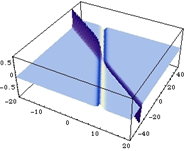On asymptotic integrability of perturbed evolution equations
Yair Zarmi
Evolution equations yield approximations to solutions of many complex dynamical systems: Propagation of light signals in an optical fiber, and of surface waves in a deep fluid layer (NLS equation); Propagation of disturbances on the surface of a shallow fluid layer, in Plasma ion acoustic waves, and the continuum limit of the Fermi-Pasta-Ulam problem (KdV equation); Propagation of weak shock waves in a fluid (Burgers equation). The evolution equations have wave solutions (e.g., solitons, shock fronts). However, perturbed evolution equations lose all the nice properties of the unperturbed equations.
The research is aimed at finding simple approximations to solutions of perturbed evolution equations that can tell us the extent of validity of the approximation. For instance, over what distance an optical signal in an optical fiber, or a wave on the surface of a fluid layer, will preserve their soliton nature.
 |
 |
| Figure 1: Two-Soliton solution of the KdV equation. | Figure 2: Wave generated spontaneously by perturbation added to KdV equation, with capacity to destroy simple structure of two-soliton solution. |
Further reading:
- On spatially non-local Burgers-like dynamical systems - A. Veksler and Y. Zarmi, Nonlinearity, 16, 1367-1380 (2003).
- Freedom in the Normal Form Expansion and Obstacles to Asymptotic Integrability: The Perturbed KdV Equation - A. Veksler & Y. Zarmi, WSEAS Transactions on Mathematics, 3, 560-565 (2004).
- Perturbative Analysis of Wave Interactions in Nonlinear Systems - A. Veksler & Y. Zarmi, Th. & Math. Phys. 144, 1227-1237 (2005).
- Wave Interactions and the Analysis of the Perturbed Burgers Equation - A. Veksler & Y. Zarmi, Physica D, 211, 57-73 (2005).
- Freedom in the Expansion and Obstacles to Integrability in Multiple-Soliton Solutions of the Perturbed KdV Equation - A. Veksler & Y. Zarmi, Physica D 217. 77-87 (2006).
- Spontaneously Generated Waves in Perturbed Evolution Equations - A, Veksler & Y. Zarmi, Nonlinearity 20 1-14 (2207).